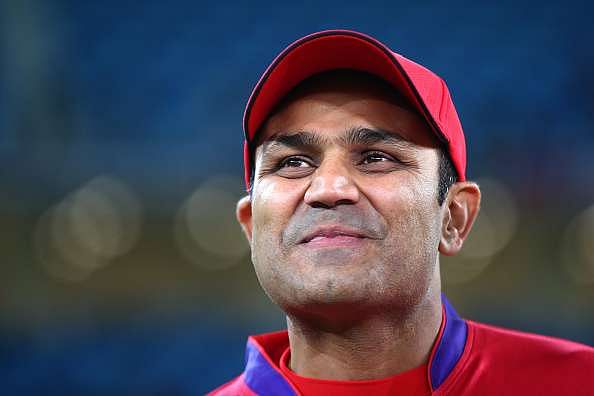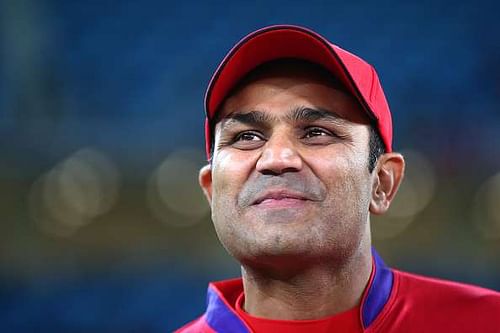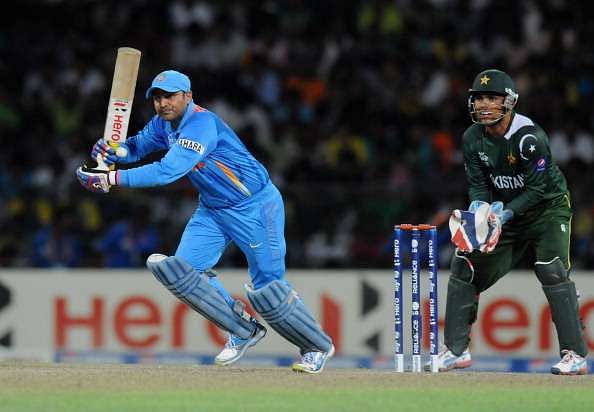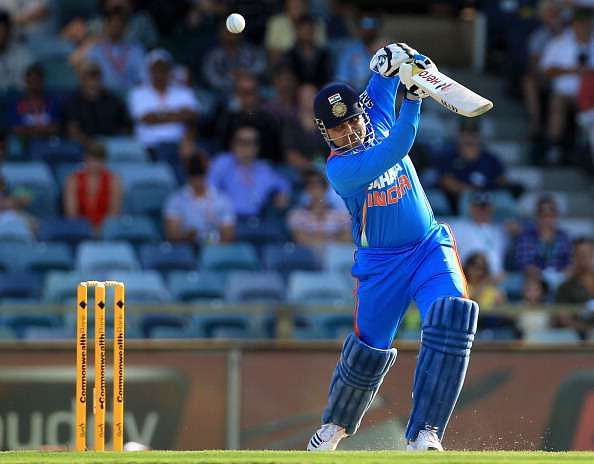
Virender Sehwag, the wisecracking genius

There is something intrepid about the dynamic and “devil may care” approach of some players from small towns in India. It is both astonishing and captivating. Nobody exemplified the above trait better than Virender Sehwag - the headline writers’ beloved “Nawab of Najafgarh”.
His stock in trade was his bewildering nonchalance. Add to that an uncanny ability to keep his approach utterly simple and the outcome on offer confounded both his peers and the paying public.
I first heard about his batting prowess from my colleague Sriram. It was after Sehwag had lathered South Zone in a Duleep Trophy game in late 1999 at Agartala. He had peeled a huge double hundred in the bargain.
South Zone’s spin attack in that game included three Indian spinners - Venkatapathy Raju, Sunil Joshi and Aashish Kapoor. Such was the contempt and utter disdain in Sehwag’s treatment of each of them that it bordered on savagery.
Eager first timers in their debut season suffer from frozen feet and obscured mindsets while doubting their beliefs and believing their doubts. But it takes a rare mindset to adapt swiftly, unfazed by reputations and differing levels of cricket.
Nascent and unpolished signs of greatness witnessed in Agartala that year stuck with him like a glue. It didn’t matter that he faced Allan Donald, Glenn McGrath, Shoaib Akhtar, Darren Gough, Muralitharan or Dale Steyn. His approach remained unchanged.
Cricket and batting is a tussle between bat and ball. It sounds pure and simple in theory when administered by a coach through a manual. But to actually embrace and imbibe it calls for clear-headed astute doing. And Viru did it in his own distinct way.
Fans from the yesteryears might have witnessed Krishnamachari Srikkanth and Tiger Pataudi adopt similar methods of shot making. But Sehwag transcended them all with consistent and longer batting stints while yielding grand-daddy hundreds. It is one thing to produce cameos while batting like him, but to last long and yet score in his style called for a rare blend of mind and sublime skill.
Also read: India vs Australia 2017: Steven Smith feels Pune wicket was more likely to suit the Indian players
Witnessing the magic in person
My first flesh and blood encounter as a teammate was in the Challenger Trophy in Chennai in the 2000/01 season. We joined forces for India Seniors at a precarious 96/5 when chasing 264 against India A.

He eased in and shredded the bowling, compiling 94 even as I made a hundred and won the man of the series award. I had the best seat in the house and could see his mind tick. His laconic remark, "how can you defend when you need a run to win," revealed and aggressive mind that always craved for runs. For him, playing a dot ball was an anathema and the last recourse.
I was forever intrigued and astonished by his talent and approach. Curious to find out what made him click, I picked his sharp cricket acumen on many a tour between 2001 and 2004. With remarkable simplicity, he reckoned that the purpose of batting was to score runs and quickly at that to set up a win. He married soft yet fast hands with an uncluttered head and an uncomplicated technique.
I witnessed the mayhem he mounted on the Sri Lankans in July 2001. He was about to be dropped by Saurav Ganguly, his mentor. Despite the pressure, he came up with a gem of a hundred. Later that year in Bloemfontein, his ability to play the new ball came in handy. With Sachin Tendulkar in tow, the duo pulled the chestnuts out of the fire in a partnership of alarming brilliance and stunning elegance.
He had arrived.
It is to Saurav's credit that the "hidden opener" was spotted. Thereafter, Viru never looked back. At the hallowed MCG, as he treated the fair dinkum Aussies with great revelry, as if in holiday mood. But he perished after lashing 195 on the first morning of the boxing day game in 2003 - finding a fielder in the deep off a full toss.
As I enquired about his feelings of a lost opportunity to score a 200, he nonchalantly uttered that he was glad to get the runs he got and preferred not to sweat about the missed double century. He said the ball was always meant to be hit, regardless of the state of the match. He was an optimist to end all optimists and never looked back.
Also read: Top-ranked Steve Smith reaches career-high rating after Pune Test
Leaving a trail of destruction
His rousing start ignited run-chases and paved the path for many an Indian win. And his batting strike-rate provided bowlers with more time to scalp 20 wickets - always a huge favour. His efforts at Multan in 2004 and then at Lahore in 2006 will forever be enshrined in Indian cricket’s fabled folklore.
His dismissal at Lahore, when on 254, robbed him of a world record for the highest opening partnership. When the then world record (held by Pankaj Roy and Vinoo Mankad) was brought to his attention, with a typical carefree shrug, Viru remarked - "Roy and Mankad, who.”
Runs almost always cascaded from his willow in a tearing torrent. He wielded the bat as if it was a wand. It seemed that he hardly tried. There was not a single negative bone in his aggressive body. His mental makeup comprised of a simple mantra - “see ball, hit ball.” With a still head and the ability to play late, he carved and sliced the bowling as he desired.
Pundits like Geoffrey Boycott reckoned that with static feet, he was bound to fail in England. But his masterclass in the summer of 2002 was a breath of fresh air to the British public - hitherto steeped in tradition and concrete batting techniques.
He rewrote the coaching manual. The upper cut on bouncy pitches off tall pacemen was one from his own book. His stint at Leicester in 2003 was alluring to say the least and his game awareness is still talked about in the county circuits.
His innate understanding of the subtle art of quick and effervescent run scoring was ingrained in him as if by mother nature. Sometimes, he made a lot of us feel envious of his abilities. As a less endowed batsman, I always wondered if he had a second helping when God was distributing talent.
Quizzed endlessly by yours truly, he would often say with refreshing candour that his best chances lay when the bowlers attacked with a hard red cherry with preying fielders behind the stumps. He said he took his chances to collar and unsettled them.
And when the field was defensive, he still had the nous to find the gaps - toying with the opposition. On some occasions, he died by the same sword but never was he deterred and never did he question his inherent, blinkered beliefs.
Therein lied the secret to his adventurous batting. "Nothing ventured, nothing gained" - this may well be his signature statement. And Viru, breathed this truism to his bone marrow. His batting attracted the ordinary masses and the discerning classes. Both the diverse lot came in swarming numbers, eager in anticipation. They were largely not disappointed.
His breathtaking ability to separate the occasion from his original and ingenuine methods enabled him to play the ball with a clear head. His 293 off 254 balls at the Brabourne Stadium against the Lankans in late 2009 was the stuff that would make the batting Gods proud.
During the course of that nuggety display, he unleashed his batting arsenal with unbridled aggression on Muralitharan and company. He might have entered a rarefied space had he got another triple ton. Alas, that wasn’t to be. Even on the 2008 tour to Sri Lanka, when the rest of the Indian side was copped up by the mystery spin of Ajantha Mendis, Sehwag was his own self.
Never once did Viru come unstuck in his ploy to tease and torment the bowlers on that tour. He pushed them to hair-pulling exasperation - all done in a series that witnessed plenty of leg-before shouts with India experiencing the DRS for the first time. Stealing toys from kids seemed a tougher proposition when compared to his rare art of bleeding the bowlers dry at will.
The final lap
His propensity to churn his usual big scores deserted him sporadically in the 2007 World Cup. This was despite a huge hundred against a minnow when the team had a collective and catastrophic meltdown in the Caribbean. He missed the English Summer of 2007 and it was Anil Kumble who stood by him when the selectors nearly showed him the door for the Australia tour in late 2007.

It is another matter that his run cupboard was indeed bare and bereft of runs. Despite 6 years of top flight cricket, he could not whip himself to compete with lesser mortals. A genius like him requires a stage and the timely hunch of a gut feel of Anil Kumble exhorted by a column from Ian Chappell proved to be decisive.
Being into the wilderness for a while aroused and rekindled the raging inner fire. And Sehwag repaid Kumble by scoring a career-reviving second inning hundred in Adelaide in January 2008. He then continued to pile it on against the hapless Proteas by taming them in scalding Chennai in early 2008. He won over endearing crowds and it was particularly pleasing that he charmed the knowledgeable Chennai audiences at his favourite ground.
Memories of his rapier-like bat haemorrhaging fast runs paved the path for many a win like the one in December 2008 against England at Chennai. What seemed at the start an impossible chase ended in a breezy canter thanks to his galloping start.
It was a real sad sight to see him struggle when the Aussies were here last in 2013. Battling with lenses, he was late on the ball with reflexes stunted a bit. He did make an honest fist of trying to carve a comeback by working zealously, even camping in Chennai. But he was never the same batsman. There was never a trace of bitterness or rancour in these tough times as he was forced to pack it in.
It is a shame that he was not given a fond farewell. Viru was a rare batting species who hardly broke into a visible sweat and yet the opposing skipper and bowlers shuddered at his bat-wielding presence. He preferred to be the fridge over the furnace-like Gautam Gambhir, his partner in many a run stealing heist.
Records came thick and fast. The honour of joining the rare bracket of batsmen to have got past the 200 run mark in an ODI was attained in 2011. And with the onset of the IPL, he regaled audiences up to 2014 while peeling runs in a manner that only he could.
I always found him to be a simple man with a large heart and never shy of a witty wisecrack to ease the nerves of one and all in the changing room. His dainty off spinners had a classical air of a parabola and broke many a partnership in vital occasions.
He elevated batting to stratospheric levels while steadfastly sticking to his simple basic philosophies. His sole purpose to occupy the crease was to go for the bowler's jugular regardless the conditions and state of the match. That " x" factor in his ability, perhaps was the clearly defining reason that brought him 22 test match hundreds.
And thousands of fans thronged the grounds to watch and soak the batting exhibition. Many a time, it felt as if he was having an outdoor net session while toying with hapless bowlers. Viru exemplified the recreational, village green amateur spirit in professional sport.
There has never been one like him before or since. There were fewer better sounds emanating from a cricket bat than from the blade of this nawab as he crunched them, almost always, from the meaty middle while parting the field with mathematical precision. Therein lay his legacy - an uncomplicated original, both as a man and as a batsman.
Thanks for the masses of entertainment Viru. You were a rare batting lodestar amidst a constellation.
Also read: Australian media hails "superhero" Steve O'Keefe after dominating win against India